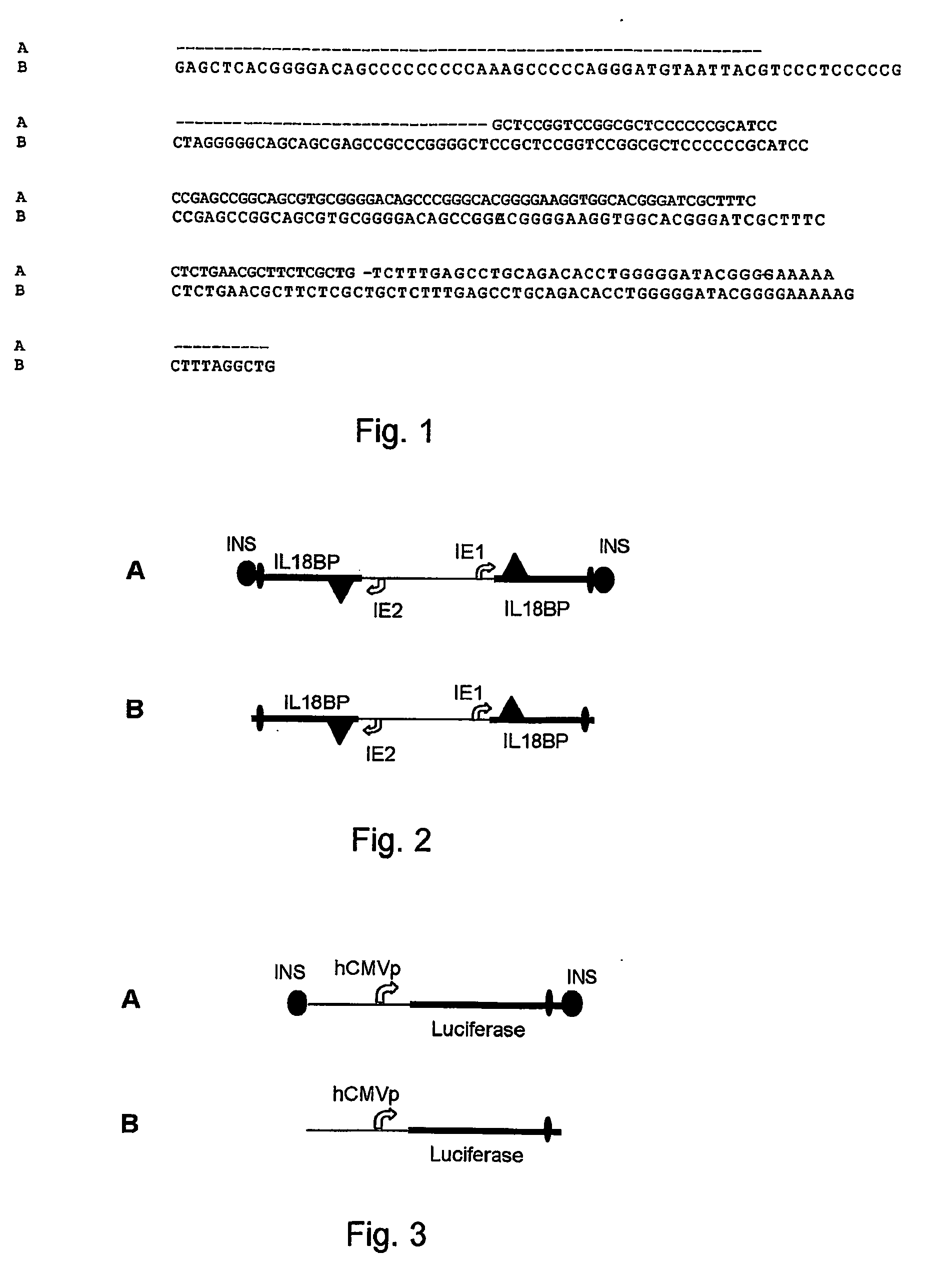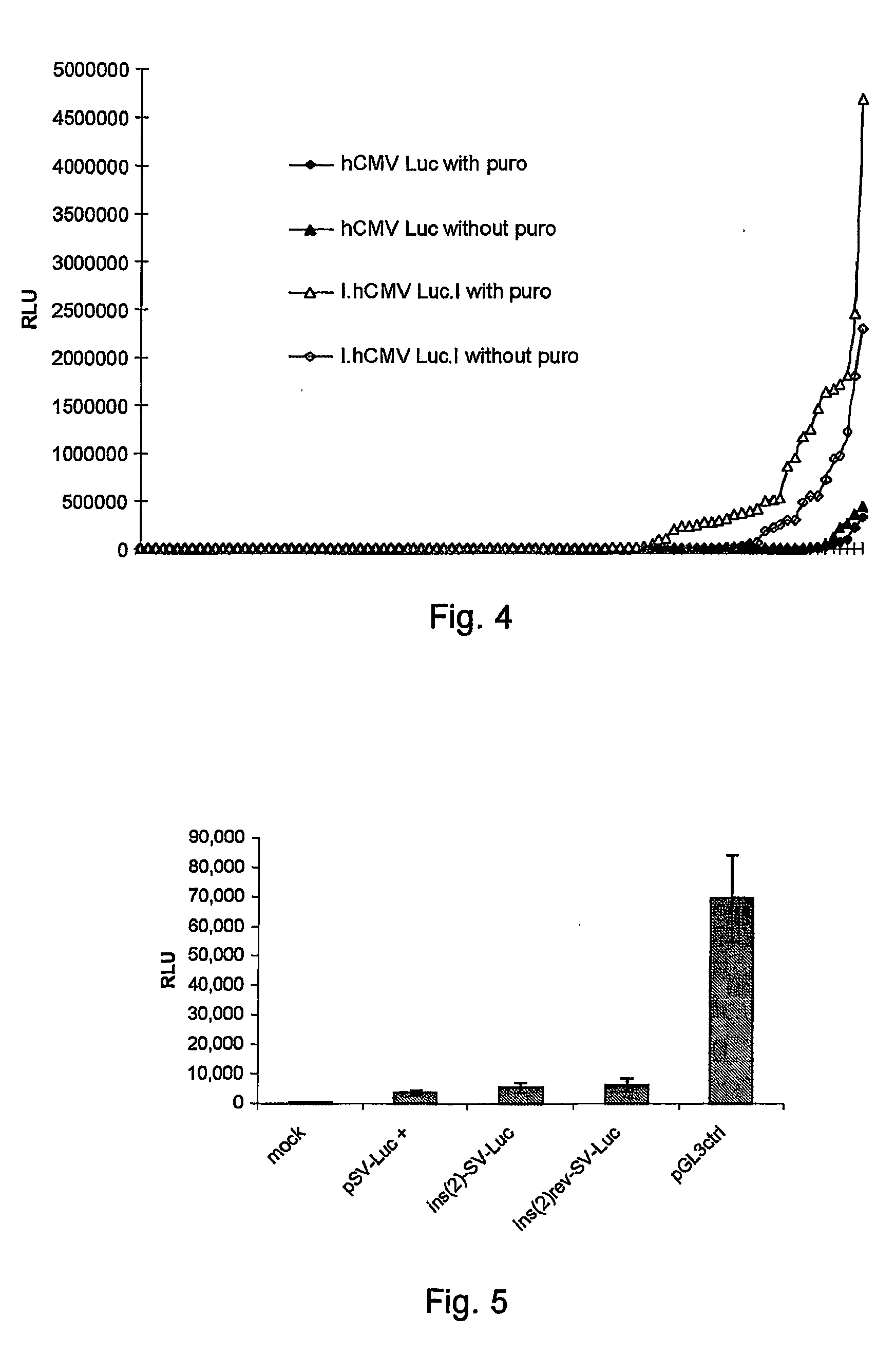Minimal dna sequence acting as a chromatin insulator and its use in protein expression
a chromatin insulator and dna sequence technology, applied in the field of expression vectors, can solve the problem of insufficient production of homogeneous transformants, and achieve the effects of stable long-term expression, increased transfection number, and high production of polypeptides of interes
- Summary
- Abstract
- Description
- Claims
- Application Information
AI Technical Summary
Benefits of technology
Problems solved by technology
Method used
Image
Examples
example 1
Construction of the Insulator and the Vectors of the Invention
Insulator
[0070] The insulator of the invention is 146 bp and has SEQ ID No:1. It comprises 146 bp of the 250 bp core sequence (SEQ ID No: 2) from the 1.2 kb insulator region of the chicken b-globin 5′HS4 locus, as shown in FIG. 1 and is further missing one base pair (around position 107 in alignment). It was assembled by oligonucleotide cloning. The resulting fragment has artificial ends for convenient subcloning.
Vectors
[0071] The 146 bp fragment was first duplicated and then cloned in two tandem arrays separated by a multiple cloning site, into the commercial cloning vector pBluescript II SK+ from Stratagene (cat no. 212205-01).
IL-18BP
[0072] A first expression cassette for a marker gene (IL18BP), expressed in two copies from a bi-directional promoter (mCMV-IE1 and mCMV-IE2), was inserted between the two insulator tandems as shown in FIG. 2A. In parallel an otherwise identical control vector devoid of the insulat...
example 2
Insulator Activity in Stably Transfected CHO Cell Pools (IL-18BP)
[0074] CHO-S cells were transfected with bi-directional reporter constructs for IL18BP expression according to FIGS. 2A and B.
Materials and Methods
[0075] Cells: CHO-S cells from Invitrogen (Cat no: 11619).
[0076] Transfection agent: DMRIE-C, Invitrogen, Cat. No. 10459-014.
[0077] Vectors: [0078] Insulated and non-insulated IL18BP expression vector described in Example 1. [0079] vector conferring puromycin resistance (puro) [0080] plasmid encoding the selection marker DHFR.
[0081] The amounts of vectors used are shown in the following table:
TABLE 1InsulatedNon-insulatedIL-18BP expression33.6 μg 30 μg vectorSelection plasmid -3 μg3 μgPuromycin resistanceSelection plasmid -3 μg3 μgDHFR
Transfection Protocol
[0082] CHO-S cells (Invitrogen, Cat no: 11619) were stably transfected using DMRIE-C (Invitrogen, Cat No. 10459-014). Briefly, 40 Mio cells were exposed for four hours to a transfection mix containing the respec...
example 3
Insulator Activity in Stably Transfected CHO Clones (Luciferase)
Materials and Methods
[0088] CHO-S cells (Invitrogen, Cat no: 11619) were stably transfected with the previously mentioned luciferase reporter constructs (see Example 1) using DMRIE-C as transfection agent. A plasmid expressing the puromycin resistance gene was cotransfected using the same protocol as described in Example 2. Two pools were established using 10 μg / ml puromycin. Stable pools were kept under selective pressure for 40 days in order to eliminate cells with unstable integration sites (phase I). The pools were measured for luciferase activity (data not shown) before seeding into 384 well plates using limiting dilution. For each pool seeding was performed both in absence and presence of puromycin in the media. Individual clones were then randomly picked and re-arrayed in 96 well plates to obtain 2 plates for each construct. These clones were then cultivated with or without puromycin for another two months up ...
PUM
| Property | Measurement | Unit |
|---|---|---|
| Composition | aaaaa | aaaaa |
Abstract
Description
Claims
Application Information
 Login to View More
Login to View More - R&D
- Intellectual Property
- Life Sciences
- Materials
- Tech Scout
- Unparalleled Data Quality
- Higher Quality Content
- 60% Fewer Hallucinations
Browse by: Latest US Patents, China's latest patents, Technical Efficacy Thesaurus, Application Domain, Technology Topic, Popular Technical Reports.
© 2025 PatSnap. All rights reserved.Legal|Privacy policy|Modern Slavery Act Transparency Statement|Sitemap|About US| Contact US: help@patsnap.com


